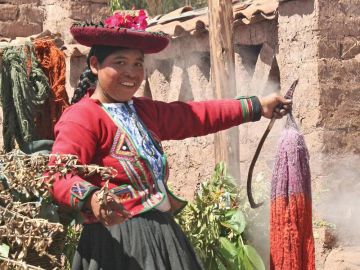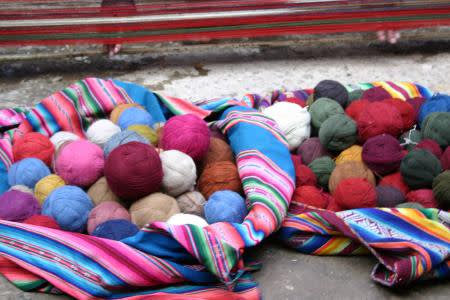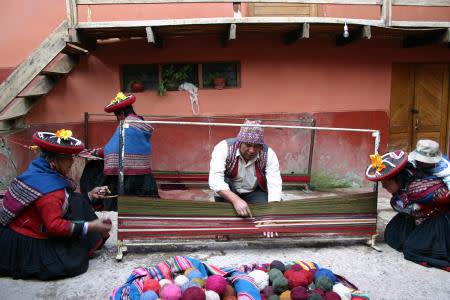
Buying Traditional Peruvian Textiles: What to Look For
At its zenith, the Inca Empire was a highly advanced society with an economy based on agriculture, pottery, metallurgy and textiles. By 1533, rumors of Inca cities filled with unimaginable riches had reached the Spanish conquistadors.
Lusting after precious metals and jewels, they rode into Cusco, where they found temples covered from floor to ceiling with sheets of hammered gold. The Spaniards killed the Inca leader, subjugated the masses, and set about stripping the kingdom of what, to them, was the most precious commodity in the world.
Textiles as Currency
To the Incas, gold was merely an adornment. Far more valuable were their alpacas and vicuñas, which produced an ultra-soft fleece that they wove into clothing, rugs and tapestries. These textiles – not gold – were used as currency throughout the empire. Soldiers and high-ranking officials were paid in alpaca garments, and clothing woven from vicuña wool was so highly prized that only members of the royal family were allowed to wear it.
The Inca had developed this ultra-fine fleece through centuries of selective breeding. They culled all but the best male alpacas and separated vicuñas and alpacas from llamas and guanacos, whose wool was much coarser. So obsessed were the Spaniards with gold that they failed to recognize the value of Inca husbandry traditions. They cross-bred alpacas with llamas, destroying centuries of genetic fine tuning. Decimated by European diseases against which they had no defense, Inca society gradually collapsed and the secrets of their breeding practices were lost to the world.
The Textiles of Peru Today
Although today’s alpaca fleece is of lesser quality than that produced by the ancient Inca, it is still one of the most desirable wools in the world. Of the four million alpacas that exist, 80% live in the central and southern regions of Peru at elevations between 10,000 feet 15,000 feet, where temperatures can swing more than 50 degrees in a single day.
As a result, they grow dense coats composed of fleece that’s extremely durable, with a high thermal quality. The herds are cared for by indigenous shepherds and breeders, who have passed their techniques down from generation to generation. Once a year, they shear the animals, harvesting five pounds of wool from each female and eight pounds from males, for a total of around 5,000 tons. Female villagers retain a portion to make sweaters, rugs, hats, gloves and coats using ancient weaving techniques. The excess is sold to textile manufacturers in the cities.
Alpaca is sorted by hand, separating the fiber by origin, quality, color and length of the fiber. Alpacas come in 22 natural earth tone colors, but white is preferred because it’s the easiest to dye. The fiber is further sorted by thickness, with the thinnest strands being the softest and most valuable. Finest of all is baby alpaca hair, the fleece from the first sheering of an alpaca.
Vicuña fleece is even finer than baby alpaca. This diminutive progenitor of the alpaca lives in wild herds scattered across the Andes highlands. Once a year, Quechua-speaking villagers round up and shear the vicuña, reaping a mere three tons of fleece. Scant supply means vicuña wool is valued between $180 and $272 per pound – higher than any other specialty fiber in the world!
Shopping for Textiles in Cusco
Today, Cusco and the villages surrounding the old Inca capital are the undisputed epicenter of Peru’s textile industry, with both alpaca and vicuña goods in high demand. But this popularity has given rise to a proliferation of bogus goods. In every market, on every street corner, vendors hawk “100% baby alpaca” products. In many cases, these garments contain only a small amount of alpaca. Fortunately, there are simple methods for determining whether an item is genuine:
- True alpaca is buttery soft, with a feel similar to human hair.
- Garments knit from 100% alpaca/vicuña do not have sewn seams. Turn the piece inside out: If you see a seam, it is likely a blend.
- The outside of garments is sometimes brushed to make the fabric feel softer, but true alpaca/vicuña needs no brushing because it is naturally soft. Compare the outside with the inside: Both should be equally soft and show no pilling, which occurs from brushing.
- Baby alpaca products are very heavy. Regular alpaca is a little less heavy, but still much heavier than synthetics or blends.
- Alpaca exhibits a silky sheen, but is not not shiny.
- Real alpaca feels cold when you touch it, where wool, synthetics and blends do not.
- Real alpaca is usually dyed in natural, earth tone colors. Brighter, gaudy colors are often a sign that a garment may be a synthetic blend.
- Since alpaca fleece does not contain Lanolin, 100% Alpaca garments are hypoallergenic and should not itch.
As for the cost of Peruvian textiles, the finer the yarn, the higher the price. You can expect to pay around $60 for an alpaca sweater and up to $80 for a baby alpaca sweater (considerably less than in the U.S. or Europe). The same sweater made from vicuña can set you back $600 or more.
It may be tempting to buy for less at markets or from street vendors, but keep in mind that textiles made from real alpaca or vicuña will last a lifetime and should be considered an investment. To ensure that your purchase is pure, it is best to buy from the reputable large mill stores in central Cusco or rely on your tour operator to introduce you to legitimate indigenous weavers in the villages around Cusco.
